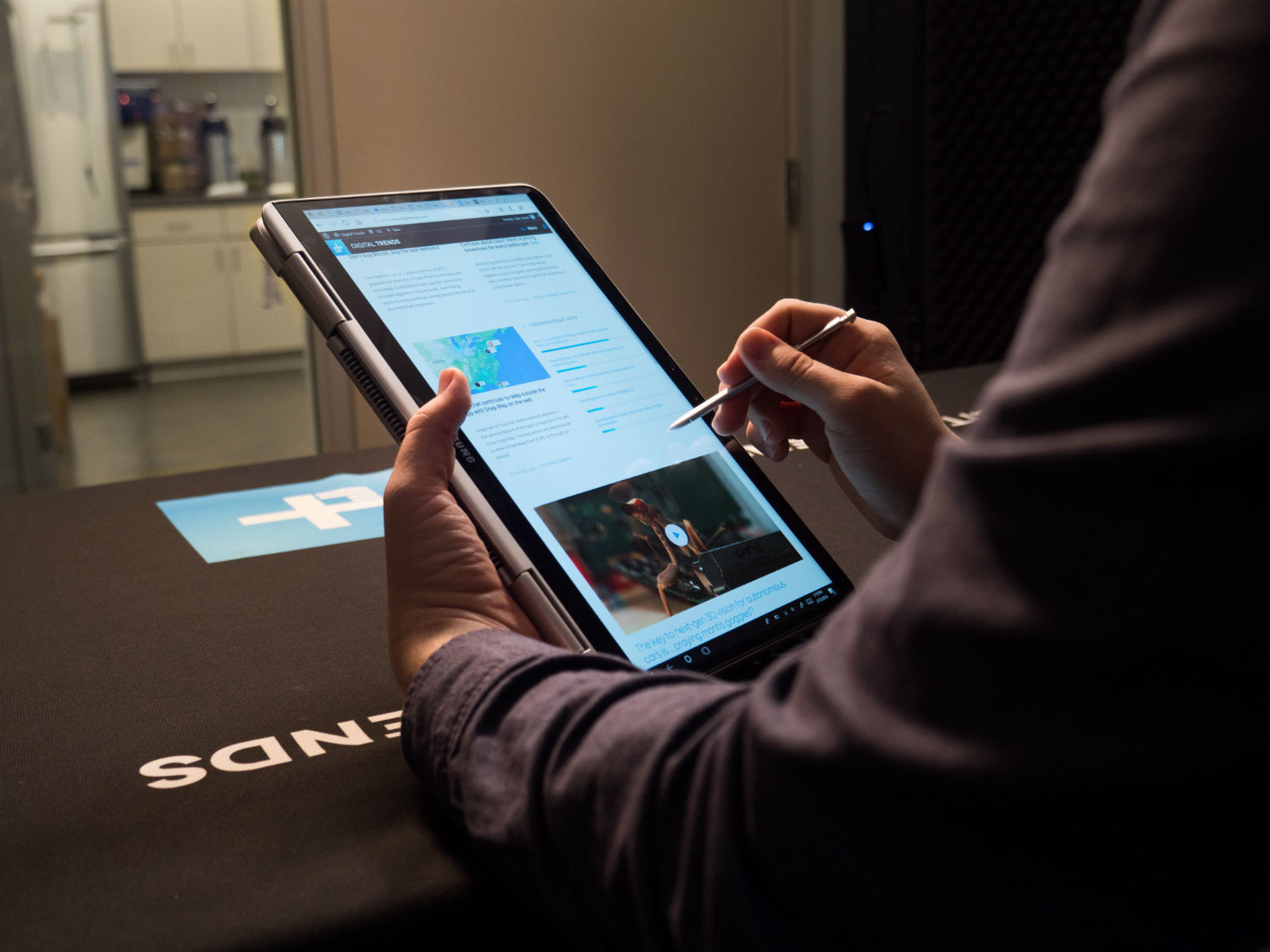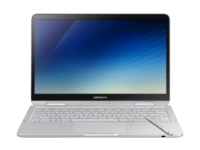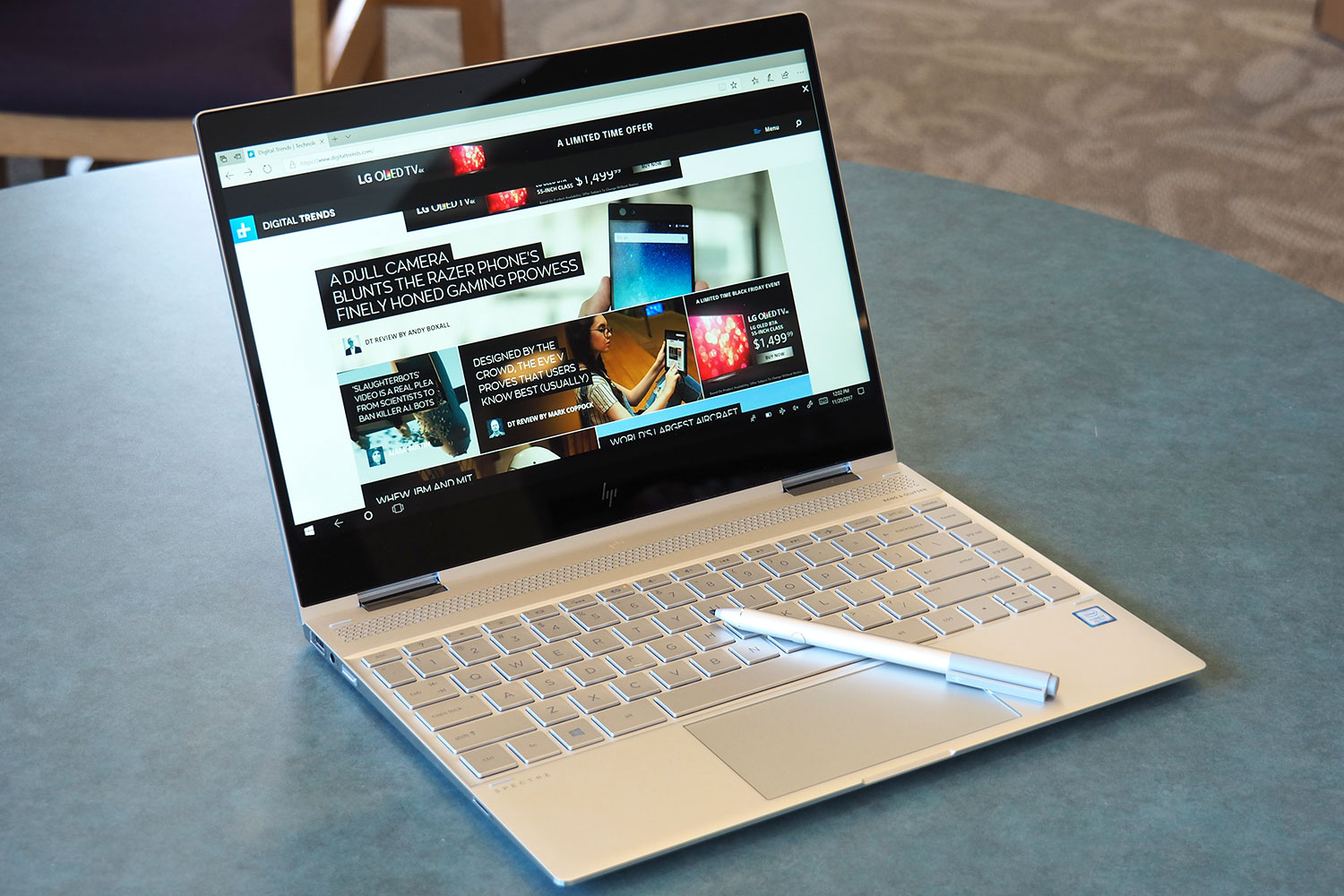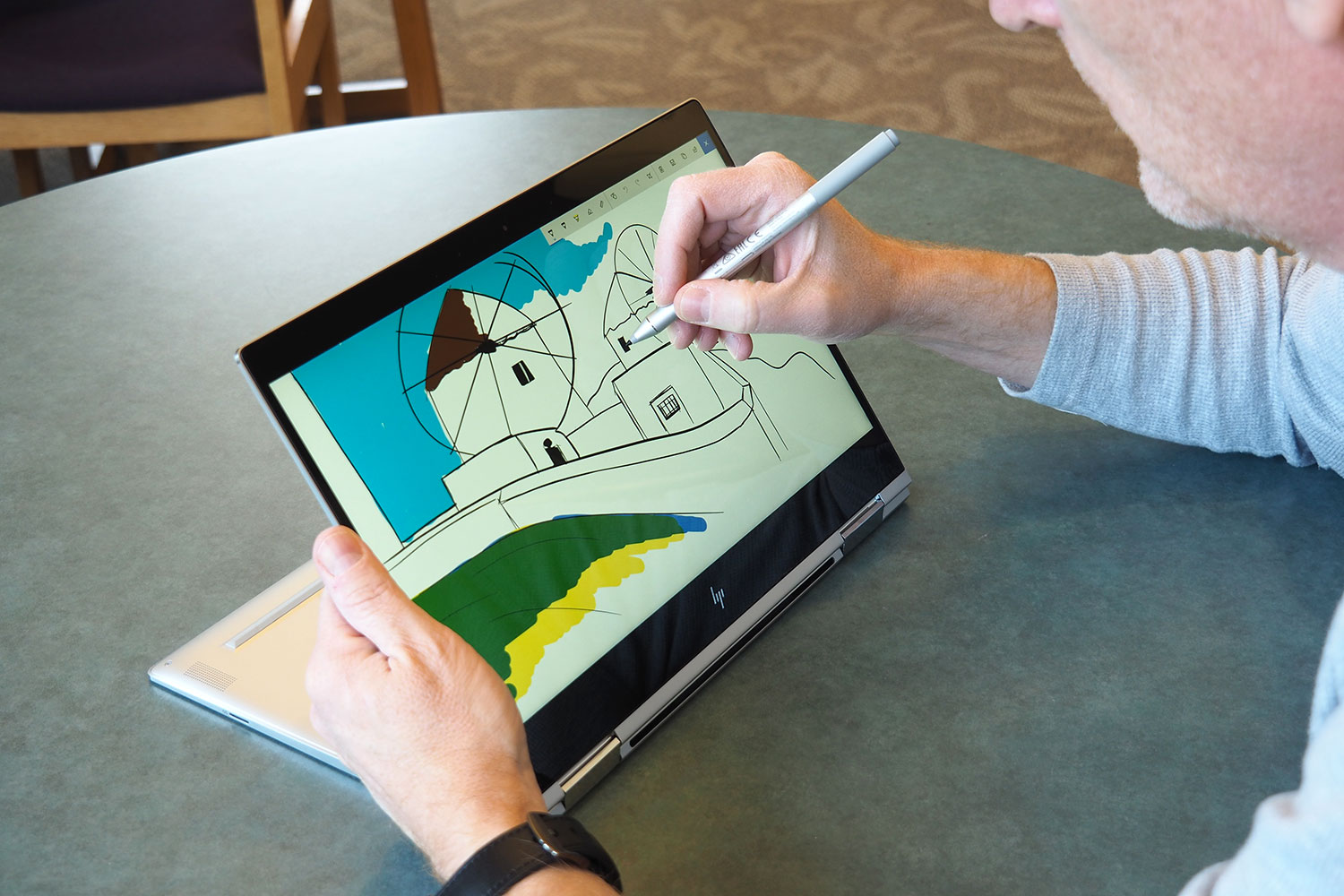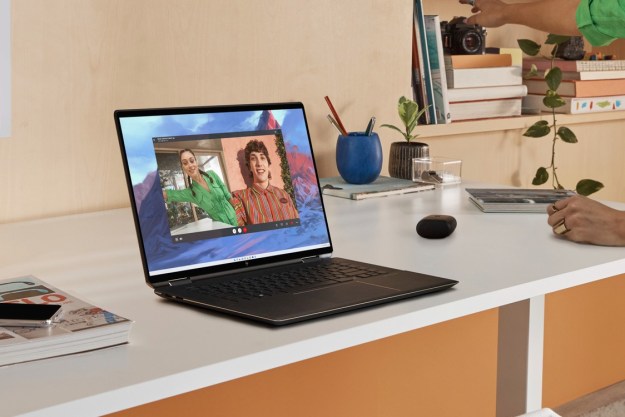If you’ve been thinking about buying a Windows 10 convertible 2-in-1, then you’ve picked a great time. There’s never been a better selection of extremely high-quality machines that can serve as excellent notebooks while providing the ability to swivel around into reasonably thin multimedia, tent, and tablet modes. Thanks to Intel’s eighth-generation quad-core CPUs, the latest crop of 2-in-1s perform extremely well when asked and sip power when appropriate.
Samsung has ramped up its own involvement in this lucrative market with its newest generation of convertible 2-in-1s, joinging HP, Dell, Lenovo, and others. In our Samsung Notebook 9 Pen vs. HP Spectre x360 shootout, we pit two 13.3-inch models against each other to see which comes out in front.
|
HP Spectre x360 13 |
Samsung Notebook 9 Pen |
|
| Dimensions | 12.04 x 8.56 x 0.53 in | 12.2 x 8.1 x 0.57-0.64 in |
| Weight | 2.78 pounds | 2.19 pounds |
| Keyboard | Full-size backlit keyboard | Full-size backlit keyboard |
| Processor | Up to eighth-generation Intel Core i7 | Up to eighth-generation Intel Core i7 |
| RAM | Up to 16GB | Up to 16GB |
| Graphics | Intel UHD 620 | Intel UHD 620 |
| Display | 13.3-inch IPS display | 13.3-inch IPS display |
| Resolution | Full HD (1,920 x 1,080 or 166 PPI) | Full HD (1,920 x 1,080 or 158 PPI) |
| Storage | Up to 1TB PCIe SSD | Up to 512GB PCIe SSD |
| Networking | 802.11ac, Bluetooth 4.1 | 802.11ac, Bluetooth 4.1 |
| Connectivity | USB-A 3.0, USB-C with Thunderbolt 3, SD card reader, 3.5mm combo jack | USB-A 3.0, USB-C, HDMI, microSD card reader, 3.5mm combo jack |
| Windows Hello | Infrared facial recognition Fingerprint scanner |
Infrared facial recognition Fingerprint scanner |
| Operating System | Windows 10 | Windows 10 |
| Battery | 63 watt-hour | 39 watt-hour |
| Price | $1,150+ | $1,400+ |
| Availability | Now | Coming soon |
| Review | 4.5 stars out of 5 | Review coming soon |
Design
HP’s Spectre x360 13 has been an extremely well-built, good-looking convertible 2-in-1 for a few generations now, and its most recent refresh only enhanced its aesthetic and quality feel. The machine received a new Dark Ash Silver and Copper accent color scheme in early 2017 that brought it in line with the rest of the Spectre line. At the end of 2017, HP widened the color pallette, adding in a Pale Rose Gold option, while adding some chiseled edges to provide for an even more modern look.
HP also shaved off some thickness, reduced the display bezels even more, and put the machine on a diet. It’s likely that the company couldn’t make the Spectre x360 13 any thinner, lighter, or good looking without sacrificing its solid build quality. In fact, the machine now has the slightest amount of give when squeezing the lid a bit too hard — it’s not really a concern at this point, but seriously, HP, here’s a good place to stop.
The Samsung Notebook 9 Pen, on he other hand, is mostly just like its predecessors. There was a switch to a black, glossy display, and the power button was repositioned to the side, but that’s about it in terms of design changes. Even given its similarity to past designs, though, the Notebook 9 Pen isn’t unattractive — its silver color scheme is good looking enough, with small bezels and a simple, dare we say conservative look.
It’s also sturdy with its magnesium alloy chassis that’s durable but very light. We noted some flex in the palm rests and keyboard, but like the Spectre x360 we didn’t consider it significant. As stated, the Notebook 9 Pen is very light, more than half a pound lighter than the the Spectre x360, in fact. Even so, it’s a bit thicker as well.
We think the Spectre x360 is simply a more stunning notebook that manages to be elegant and luxurious without being ostentatious. It also feels a bit more solid, in spite of being slightly thinner. HP gets a strong win in this round.
Winner: HP Spectre x360
Performance
The Spectre x360 is equipped with Intel’s most up-to-date mobile CPUs, the eighth-generation Intel Core series, with i5 and i7 options. We reviewed a unit with the Intel Core i7-8550U, close to the series high-end. The i7 has four cores versus two in previous generation, and its clock speed can be optimized for either top performance when tasks demand it or greater efficiency when battery life is most important. HP makes good use of the newest chip, with excellent performance for any notebook, let alone such a thin and light machine.
Samsung chose the same CPU for the Notebook 9 Pen, promising similar performance. And in fact, that was mostly the case, with both machines scoring similarly in our synthetic benchmark tests. Furthermore, the Notebook 9 Pen seemed just as quick in real-life usage. One difference, however, is that Samsung’s 2-in-1 suffered from some thermal issues, with the chassis getting unusually hot and the fans unusually loud — even during basic productivity work.
That’s not something we noticed with the Spectre x360, meaning that HP did a better job of managing heat in its thin and light chassis than Samsung. For that reason, we’re giving the slight win to HP in this category.
Winner: HP Spectre x360
Keyboard, Mouse, and Pen
The HP Spectre x360 13’s keyboard is snappy and precise, letting us get up to speed immediately and offering a comfortable feel for long typing sessions. That’s a distinctly different experience than the Samsung Notebook 9 Pen’s keyboard, which had similar 1.5mm travel but a soft bottoming action that we found imprecise and squishy. Both keyboards are backlit, but HP’s was more even across all of the keys.
The HP’s touchpad uses Synaptic drivers rather than the more responsive Microsoft Precision Touchpad protocol, but we also found the Samsung’s Microsoft Precision touchpad to be a bit broken. The Notebook 9 Pen’s touchpad is also smaller than we like, and the buttons were too stiff. In spite of rejecting Microsoft’s Precision Touchpad drivers, HP did a better job here as well.
Finally, we like Samsung’s S Pen software, which adds some real value to the inking experience with a pen that’s more precise than HP’s Active Pen, with the more modern 4,096 levels of pressure sensitivity versus the Spectre x360 13’s 1,024. HP does supports tilt, though, and it has a rechargeable battery and a built-in gyroscope that lets it function as a sort of “laser pointer” for giving presentations. Unfortunately, the S Pen is also much smaller and flimsier, and we found it designed more for quicker notes and sketches.
We liked Samsung’s S Pen functionality, but given the HP’s superior keyboard and touchpad, we’re compelled to once again award HP the win.
Winner: HP Spectre x360
Connectivity
The Spectre x360 13 boasts a single USB-A 3.0 port, two USB-C ports with Thunderbolt 3 support, and a 3.5mm combo audio jack. The Notebook 9 Pen is a little more old-school and limited, with two USB-A 3.0 ports, a USB-C 3.1 Gen1 port, and an HDMI port. That make the HP more future-proof, with the expansive display options, high-end peripheral, and external GPU support provided by Thunderbolt 3 compliance while a little less backward-looking.
Both machines offer SD card readers (with Samsung’s being of the micro variety), to go along with 2×2 MU-MIMO Wi-Fi and Bluetooth. Both also offer both infrared facial recognition and fingerprint readers for Windows 10 Hello support.
While we appreciate Samsung’s legacy support, you just can’t beat Thunderbolt 3 ports for their far more advanced connectivity. And the Spectre x360 has two of them!
Winner: HP Spectre x360
Display
The Spectre x360 13’s 13.3-inch Full HD (1,920 x 1,080 or 166 PPI) display is average at best. Its contrast, brightness, and color support were all smack dab in the middle of the pack, according to our colorimeter, while subjectively we enjoyed the display but thought it was just the slightest bit too light for watching video.
The Notebook 9 Pen’s 13.3-inch Full HD display was better, with similar contrast and brightness but a wider color gamut. It was also closer to true life in terms of its gamma, meaning videos will theoretically look better, and its colors are also more accurate.
HP does offer an advantage in terms of the displays that are available for its 2-in-1. Specifically, it offers a 4K UHD option (3,840 x 2,160, or 331 PPI), and the Spectre x360 13 also inherits the HP Sure View privacy screen from the business-class Elitebook x360 G2. If you work with sensitive data that you want to keep safe from prying eyes, then the HP is the better choice. Overall, the slight improvement in colors isn’t enough to take away HP’s high-res advantage.
Winner: HP Spectre x360
Portability and Battery Life
As we noted earlier, Intel has built both high performance and great efficiency into its eighth-generation CPUs. If you’re performing demanding tasks like video editing, then the processors will tax your battery, but scale back to Office, web browsing, or watching a movie and they’ll last a good long while.
Battery life in this comparison was a bit of a surprise. The Spectre x360 13 packs in 63 watt-hours of battery life to the Notebook 9 Pen’s 39 watt-hours. And yet, the Samsung managed to remain competitive. It lasted a few more minutes in our video looping test, and actually held out longer in our most aggressive Basemark web benchmark test. The Spectre x360’s extra battery capacity did prove itself in our web browsing test, lasting twice as long.
In the end, the HP’s slightly lower performance when pushing the CPU hard and its smaller screen resulted in much better battery life in our aggressive Basemark browser benchmark test and just slightly better battery life when browsing the web and looping a local video.
When two machines can play video for roughly 14 hours, that’s impressive. But the Samsung’s lighter frame makes it easier to throw in a backpack and carry around, and that’s not nothing.
Winner: Samsung Notebook 9 Pen
Availability and Price
The Spectre x360 13 and the Notebook 9 Pen are both premium notebooks, but Samsung is asking a bit more of a premium for its 2-in-1. When equipped with the Core i7-8550U, 8GB of RAM, a 256GB SSD, and a Full HD display, the Spectre x360 13 retails for $1,250 while the Notebook 9 Pen lists for $1,400. Given the HP’s wins in so many categories, it’s hard not to argue that it’s the better bargain.
Winner: HP Spectre x360 13
The HP Spectre x360 13 wins this one hands-down
The HP Spectre x360 is our favorite convertible 2-in-1, and for good reason. It’s well-built, extremely good looking, has great performance, and lasts a full working day on a charge. The Samsung Notebook 9 Pen has some nice software to make notetaking and sketching a bit easier, but it’s not as if the HP’s support for Windows 10 Ink is anything to scoff at.
The bottom line is that the Spectre x360 just feels like the better machine in pretty much every category. You’ll spend less money, but feel like you got considerably more machine.
Editors' Recommendations
- Why the latest ThinkPad X1 Yoga Gen 8 isn’t worth the upgrade
- HP Envy x360 13 vs. Dell XPS 13: the best tiny laptop?
- Asus ZenBook S 13 Flip vs. HP Spectre x360 13.5: you can’t go wrong
- New HP Spectre x360 16 ditches Nvidia, embraces Intel Arc
- Lenovo ThinkPad X12 Detachable vs. Microsoft Surface Pro 8
